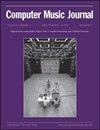声音选集:节目说明
IF 0.4
Q4 COMPUTER SCIENCE, INTERDISCIPLINARY APPLICATIONS
引用次数: 0
摘要
电声音乐在拉丁美洲有着悠久而丰富的传统,尽管该地区在其整个存在过程中经历了许多政治和经济动荡。在没有太多公共或私人支持的情况下,Maurico Kagel、Reginaldo Carvalho、Jorge Antunes、JoséVicente Asuar、Juan Amenabar、Juan Blanco、Carlos Jiménez Mabarak和Franciso Kröpfl等作曲家为现在充满活力和活跃的拉丁美洲计算机音乐社区奠定了基础。里卡多·达尔·法拉(Ricardo Dal Farra)在本期特刊中的文章,我们鼓励读者访问,对这一流派在该地区的发展进行了深刻而重要的描述。需要强调的一个有趣的事实是,在一个通信没有今天那么快速和丰富的时代,欧洲第一批浓缩音乐和电子音乐作品与拉丁美洲同行之间的时间差距并不是很长。卡格尔创作的第一批拉丁美洲作品可以追溯到20世纪50年代初,1956年创作了第一批智利和巴西作品。我们认为,这是一个证据,表明这一流派在拉丁美洲地区的历史和进步与更知名的欧洲或北美同类流派一样丰富和重要。拉丁美洲计算机音乐的另一个重要方面本文章由计算机程序翻译,如有差异,请以英文原文为准。
Sound Anthology: Program Notes
Electroacoustic music has a long and rich tradition in Latin America, despite the many instances of political and economic turbulence that the region has experienced throughout its existence. Without much public or private support, composers such as Maurico Kagel, Reginaldo Carvalho, Jorge Antunes, José Vicente Asuar, Juan Amenabar, Juan Blanco, Carlos Jiménez Mabarak, and Franciso Kröpfl, among many others, established the foundations of what is now a vibrant and active Latin American computer music community. Ricardo Dal Farra’s article in this special issue, which we encourage the reader to visit, provides a profound and important account of the development of this genre in the region. One interesting fact to emphasize is that, in an era when communications were not as rapid and abundant as they are today, the time gap between the first European compositions of musique concrète and electronic music and their Latin American counterparts was not very long. The first Latin American works, created by Kagel, date from the early 1950s, and in 1956 the first Chilean and Brazilian pieces were composed. This, we believe, is evidence suggesting that the history and advances of this genre in the Latin American regions are as rich and important as the better-known European or North American equivalents. Another important aspect of the computer music of Latin America
求助全文
通过发布文献求助,成功后即可免费获取论文全文。
去求助
来源期刊

Computer Music Journal
工程技术-计算机:跨学科应用
CiteScore
1.80
自引率
0.00%
发文量
2
审稿时长
>12 weeks
期刊介绍:
Computer Music Journal is published quarterly with an annual sound and video anthology containing curated music¹. For four decades, it has been the leading publication about computer music, concentrating fully on digital sound technology and all musical applications of computers. This makes it an essential resource for musicians, composers, scientists, engineers, computer enthusiasts, and anyone exploring the wonders of computer-generated sound.
Edited by experts in the field and featuring an international advisory board of eminent computer musicians, issues typically include:
In-depth articles on cutting-edge research and developments in technology, methods, and aesthetics of computer music
Reports on products of interest, such as new audio and MIDI software and hardware
Interviews with leading composers of computer music
Announcements of and reports on conferences and courses in the United States and abroad
Publication, event, and recording reviews
Tutorials, letters, and editorials
Numerous graphics, photographs, scores, algorithms, and other illustrations.
 求助内容:
求助内容: 应助结果提醒方式:
应助结果提醒方式:


